A New Approach in Heat Transfer Analysis: Reduced-Scale Straight Bars with Massive and Square-Tubular Cross-Sections
Abstract
:1. Introduction
2. Materials and Methods
- -
- is the measured temperature of the bar;
- -
- is the estimated value of the theoretical temperature;
- -
- —constants;
- -
- —the ambient temperature;
- -
- is a widely applied parameter:
- -
- is the so-called shape factor (the massivity) of the bar as ratio of the cross-section’s circumference and its area;
- -
- —the bar’s nappe heat
- -
- transfer coefficient;
- -
- —the bar’s material thermal conductivity coefficient.
- In the first case (k = I), where the total length of the bar/tested specimen was , nine thermocouples were mounted, located next each to other at the same distance apart of 0.005 m (with for all of the -cases); in addition, the tenth monitored point was practically the lower end of the bar (the point O), with the predicted nominal temperature;
- For case k = II., with , there were five supplementary holes, disposed to each other at 0.010 m distance;
- In the case k = III., with , the authors supplemented the setup with other five thermocouples, at 0.010 m from each other, and consequently there were nine thermocouples apart, one other at point O, and ten thermocouples 0.010 m apart;
- For the case k = IV., with , the other five supplementary thermocouples were located 0.010 m apart.
- —the appropriate temperature mean;
- —the measured temperature;
- —the mean value of the ambient temperature along the whole length of the tested bar;
- —the relative error with respect to the measured data.
- One can also mention that this is the real explanation of the two-decimal temperature values during these above-mentioned experimental investigations, and from the sets of thirty values of course one will obtain this accuracy;
- Even for a first attempt, the () coefficients, when the hypothesis of is accepted, will be considered also to be constants along the bar, but for a more accurate calculation, the authors in the aforementioned reference [1] proposed an original and more accurate approach for their variation along the bar, i.e., .
- Briefly, from the definition of the parameter m, rel. (3), one can obtain the rel. (5), corresponding to , and the can be expressed as a second-order temperature curve :
- We accepted natural convection between the upper end of the bar and the ambience, and correspondingly, from the literature one can obtain the Nusselt number Nu [-], a function of the Pr [-] Prandtl number and the Ra [-] Rayleigh one: Nu = f(Pr, Ra).
- From the same reference, corresponding to the horizontal positioned bar, one has (2)
- For the vertical positioned one:
- The whole protocol is detailed in reference [1].
- to validate the theoretical thermal distribution law (2) from [25];
- to validate the hypothesis of in the case of the bars with massive cross-sections;
- to establish, in the hypothesis of , the values of the parameters () required to determine the theoretical distribution law that fully matches the experimentally obtained law in the case of the given bar with a massive cross-section (with the square of the multiple correlation coefficient ), destined for further numerical simulations;
- to highlight the significant influences of the bar’s length and its angular positioning on the magnitude and shape of the effective thermal distribution law.
3. Results
4. Discussion
- For the massive circular cross-section, one has:from which, for , one will obtain , and for , one will obtain
- For the square-tubular cross-section, one will obtain
- This difference is certainly the consequence of the different heat transfer between the bar’s nappe and the environment. When one has a horizontally positioned bar (), the heat transmitted to the environment between two neighboring thermocouples (i.e., through the corresponding cylindrical surface of the bar’s nappe) will not influence the heating of the next zones (nappe’s area), obtaining greater heat loss.
- Together with the nominal temperature increase, the temperature loss became greater (i.e., the heat exchange became better);
- Comparing the three analyzed cross-sections, one can conclude that the best heat exchange will be offered by the square and tubular cross-section, as for it, always had the minimal value, followed by the massive circular one, which was in diameter;
- This difference became greater with the increase in the monitored length of the bar;
- Even the square-tubular cross-sectional bar has an intermediate value of the shape factor , its heat-exchange is the best, followed by the massive circular one, with in diameter;
- It seems that this special behavior of the square-tubular cross-sectional bar is due to the fact that, as shown below, the hypothesis is not valid for the whole length of the bar, but rather for some smallest intervals; consequently, the thermal distribution law will finally present a greater gradient than those unique curves, which can be drawn based on the hypothesis for all their length.
- Together with the temperature increase, an adequate increase in m’s curves’ values was obtained;
- The greatest gradient of m’s curves is observable in the first interval (i.e., in the first case of the , and for , corresponding to the cases of the and ;
- The plotted curves are practically the same for all three (angular positioning values) with respect to a given nominal temperature.
- The greatest gradient is for the first interval , where, from 100%, the will decrease down to 62.3%;
- For the second interval, , the change was from 62.3% down to 57%, and in the third interval, , from 57% down to 36.8%;
- It should be mentioned that the third interval represents 90% of the whole bar length , and consequently, this decrease is very small considering the monitored length of the bar;
- In a similar manner, for other nominal temperatures, the mentioned calculi of can be used, and consequently, it can become possible to obtain the predictable values for “m” along the bar without difficult analytical calculi.
5. Conclusions
- In this study, the authors described a novel approach to the evaluation of the temperature distribution by means of some new parameters, based on the experimentally obtained temperature distribution laws for some reduced-scale, modelled straight steel bars;
- The experiment involved the use of an original testing bench described in a previous paper [1];
- The tested bars (reduced-scale, modelled steel bars) were fitted with thermocouples: twenty-four, in the case of the bars with massive cross-sections, and sixteen, for the square-tubular bars. The thermocouples monitored the temperature distribution along the bar; one other supplementary thermocouple offered the environment’s temperature during the experiments;
- The analyzed bars had massive circular and square-tubular cross-sections;
- The authors demonstrated that both the least-square method and the curve-fitting method offer more accurate approaches with respect to the experimental data than the theoretical law (so-called “exponential”) described by Equation (2);
- By means of the proposed relative , thermal distribution curves were obtained (for a given nominal temperature of the heated end) with a generalized distribution law along the bar, where represents the remaining percentage of the (considered to be 100%);
- These curves have a particular shape for each type and dimension of the cross-section, and for shape factor too;
- By introducing the compared temperature loss, , the authors obtained a clearer image of the temperature reduction phenomenon;
- One other proposed parameter was a dimensionless product of the shape factor and the bar’s length, also a useful element in thermal analysis of the straight bars;
- Starting from the theoretical relation for m’s calculus, we plotted “m” vs. the bar’s length , taking into account different nominal temperatures and angular positioning of the bar;
- A thorough examination of the obtained curves for the square-tubular cross-sectional bars made it possible to distinguish three different intervals, having different gradients of “m” variation, where, by means of the curve-fitting method, different variation laws were obtained; the first interval presented the greatest gradient;
- Based on the obtained curves, for a given nominal temperature and without respect to the angular positioning of the bar , we propose to introduce the relative curve, which monitors the remaining percentage of the initial value (for ) of “m,” which is considered to represent 100%;
- The authors suggest that these new approaches to generating the theoretical results with the temperature distribution law can be applied successfully in thermal analyses of 2D and 3D structures, in the first stage on reduced scale models, and then in real-scale structures, too;
- The experiment involved the use of an original testing bench, which is described in the paper.
Author Contributions
Funding
Data Availability Statement
Acknowledgments
Conflicts of Interest
References
- Turzó, G.; Száva, I.-R.; Gálfi, B.-P.; Száva, I.; Vlase, S.; Hota, H. Temperature distribution of the straight bar, fixed into a heated plane surface. Fire Mater. 2018, 48, 202–212. [Google Scholar] [CrossRef]
- Andreozzi, A.; Bianco, N.; Musto, M.; Rotondo, G. Scaled models in the analysis of fire-structure interaction, 33rd UIT (Italian Union of Thermo-fluid-dynamics) Heat Transfer Conference. In Journal of Physics: Conference Series; IOP Publishing: Bristol, UK, 2015; Volume 655, p. 012053. [Google Scholar] [CrossRef]
- Bączkiewicz, J.; Malaska, M.; Pajunen, S.; Heinisuo, M. Experimental and numerical study on temperature distribution of square hollow section joints. J. Constr. Steel Res. 2018, 142, 31–43. [Google Scholar] [CrossRef]
- He, S.-B.; Shao, Y.-B.; Zhang, H.-Y.; Yang, D.-P.; Long, F.-L. Experimental study on circular hollow section (CHS) tubular K-joints at elevated temperature. Eng. Fail. Anal. 2013, 34, 204–216. [Google Scholar] [CrossRef]
- He, S.-B.; Shao, Y.-B.; Zhang, H.-Y.; Wang, Q. Parametric study on performance of circular tubular K-joints at elevated temperature. Fire Saf. J. 2015, 71, 174–186. [Google Scholar] [CrossRef]
- He, S.-B.; Shao, Y.-B.; Zhang, H.-Y. Evaluation on fire resistance of tubular K-joints based on critical temperature method. J. Constr. Steel Res. 2015, 115, 398–406. [Google Scholar] [CrossRef]
- Yang, J.; Shao, Y.B.; Chen, C. Experimental study on fire resistance of square hollow section (SHS) tubular T-joint under axial compression. Adv. Steel Constr. 2014, 10, 72–84. [Google Scholar]
- Gao, F.; Guan, X.-Q.; Zhu, H.-P.; Liu, X.-N. Fire resistance behaviour of tubular T-joints reinforced with collar plates. J. Constr. Steel Res. 2015, 115, 106–120. [Google Scholar] [CrossRef]
- Kado, B.; Mohammad, S.; Lee, Y.H.; Shek, P.N.; Ab Kadir, M.A. Temperature Analysis of Steel Hollow Column Exposed to Standard Fire. J. Struct. Technol. 2018, 3, 1–8. [Google Scholar]
- Ferraz, G.; Santiago, A.; Rodrigues, J.P.; Barata, P. Thermal Analysis of Hollow Steel Columns Exposed to Localised Fires. Fire Technol. 2016, 52, 663–681. [Google Scholar] [CrossRef]
- Franssen, J.-M. Calculation of temperature in fire-exposed bare steel structures: Comparison between ENV 1993-1-2 and EN 1993-1-2. Fire Saf. J. 2006, 41, 139–143. [Google Scholar] [CrossRef]
- Ghojel, J.I.; Wong, M.B. Heat transfer model for unprotected steel members in a standard compartment fire with participating medium. J. Constr. Steel Res. 2005, 61, 825–833. [Google Scholar] [CrossRef]
- Sova, D. Heat Engineering; Transilvania University Press: Brasov, Romania, 2006; ISBN 9789736357664. [Google Scholar]
- Sova, D. Applied Thermodynamics; Transilvania University Press: Brasov, Romania, 2015; ISBN 9786061907144. [Google Scholar]
- Incropera, F.P.; DeWitt, D.P.; Bergman, T.L.; Lavine, A.S. Fundamentals of Heat and Mass Transfer; John Wiley & Sons Ltd.: Chichester, UK, 2002. [Google Scholar]
- Ştefănescu, D.; Marinescu, M.; Dănescu, A. Heat Transfer in Technique; Editura Tehnică: Bucharest, Romania, 1982; Volume 1. [Google Scholar]
- Franssen, J.-M.; Real, P.V. Fire Design of Steel Structures, ECCS Eurocode Design Manuals, ECCS-European Convention for Constructional Steelwork; John Wiley & Sons Ltd.: Chichester, UK, 2010. [Google Scholar]
- Carslaw, H.S.; Jaeger, J.C. Conduction of Heat in Solid, 2nd ed.; Oxford Science Publications: New York, NY, USA, 1986. [Google Scholar]
- Környey, T. Heat Transfer; Műegyetemi Kiadó: Budapest, Romania, 1999. [Google Scholar]
- Bejan, A. Convection Heat Transfer; John Wiley & Sons: Hoboken, NJ, USA, 2013. [Google Scholar]
- Yang, K.-C.; Chen, S.-J.; Lin, C.-C.; Lee, H.-H. Experimental study on local buckling of fire-resisting steel columns under fire load. J. Constr. Steel Res. 2005, 61, 553–565. [Google Scholar] [CrossRef]
- Hirashima, T.; Okuwaki, K.; Zhao, X.; Sagami, Y.; Toyoda, K. An Experimental Investigation of Structural Fire Behaviour of a Rigid Steel Frame, Fire Safety Science-Proceedings of The Eleventh International Symposium. Fire Saf. Sci. 2014, 11, 677–690. [Google Scholar] [CrossRef] [Green Version]
- Krishnamoorthy, R.R.; Bailey, C.G. Temperature distribution of intumescent coated steel framed connection at elevated temperature. In Proceedings of the Nordic Steel Construction Conference ‘09, Malmo, Sweden, 2–4 September 2009; Swedish Institute of Steel Construction: Stockholm, Sweden, 2009; Volume 181, pp. 572–579. [Google Scholar]
- de Silva, V.P. Determination of the temperature of thermally unprotected steel members under fire situations considerations on the section factor. Lat. Am. J. Solids Struct. 2006, 3, 113–125. [Google Scholar]
- Turzó, G. Temperature distribution along a straight bar sticking out from a heated plane surface and the heat flow transmitted by this bar. Theoretical approach, Annals of Faculty of Engineering Hunedoara. Int. J. Eng. 2016, 14, 49–53. [Google Scholar]
- Wang, F.; Zhao, Q.; Chen, Z.; Fan, C.M. Localized Chebyshev collocation method for solving elliptic partial differential equations in arbitrary 2D domains. Appl. Math. Comput. 2021, 397, 125903. [Google Scholar] [CrossRef]
- Wang, C.; Wang, F.; Gong, Y. Analysis of 2D heat conduction in nonlinear functionally graded materials using a local semi-analytical meshless method. AIMS Math. 2021, 6, 12599–12618. [Google Scholar] [CrossRef]
- Wang, F.; Hua, Q.; Liu, C.S. Boundary function method for inverse geometry problem in two-dimensional anisotropic heat conduction equation. Appl. Math. 2018, 84, 130–136. [Google Scholar] [CrossRef]

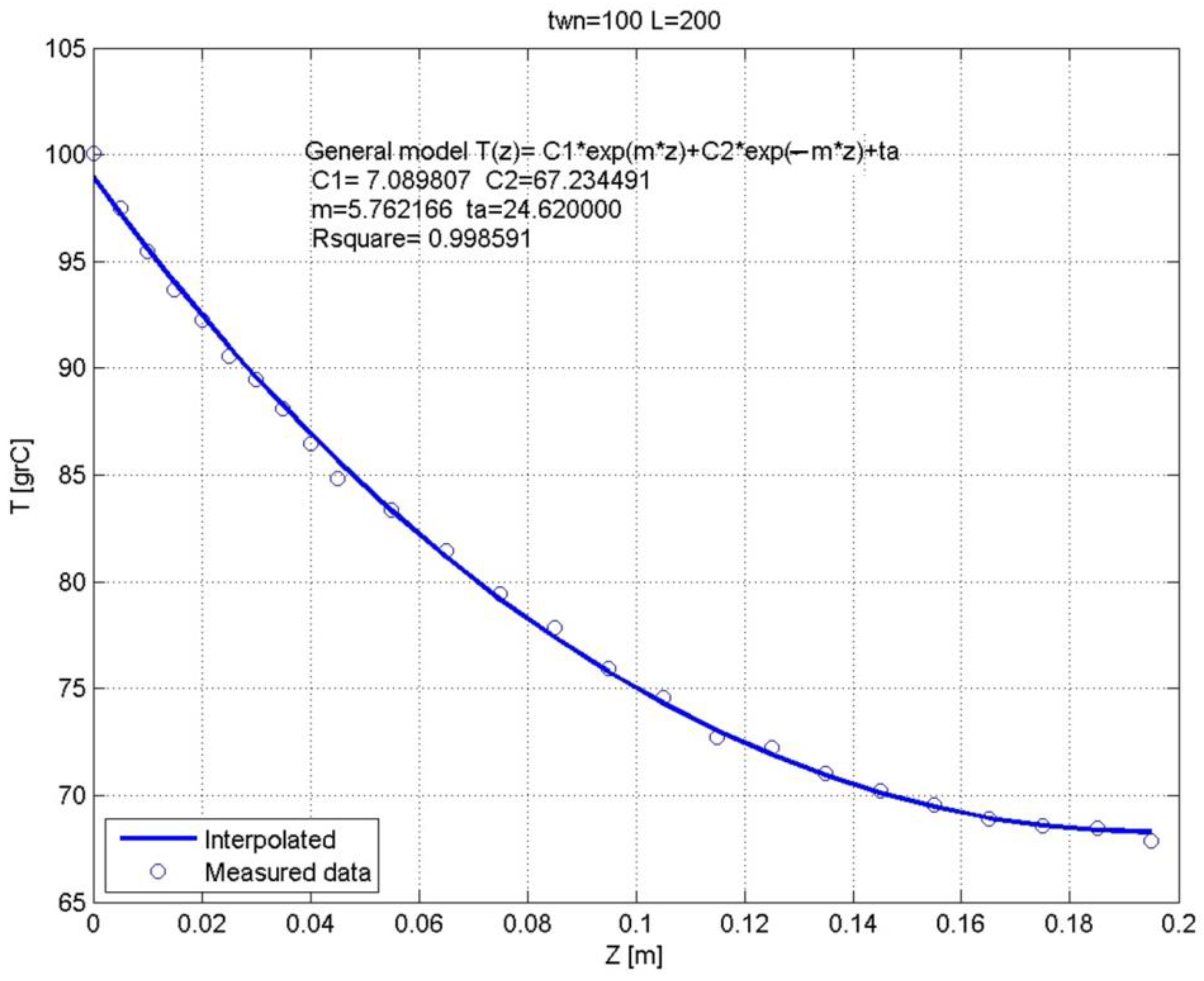
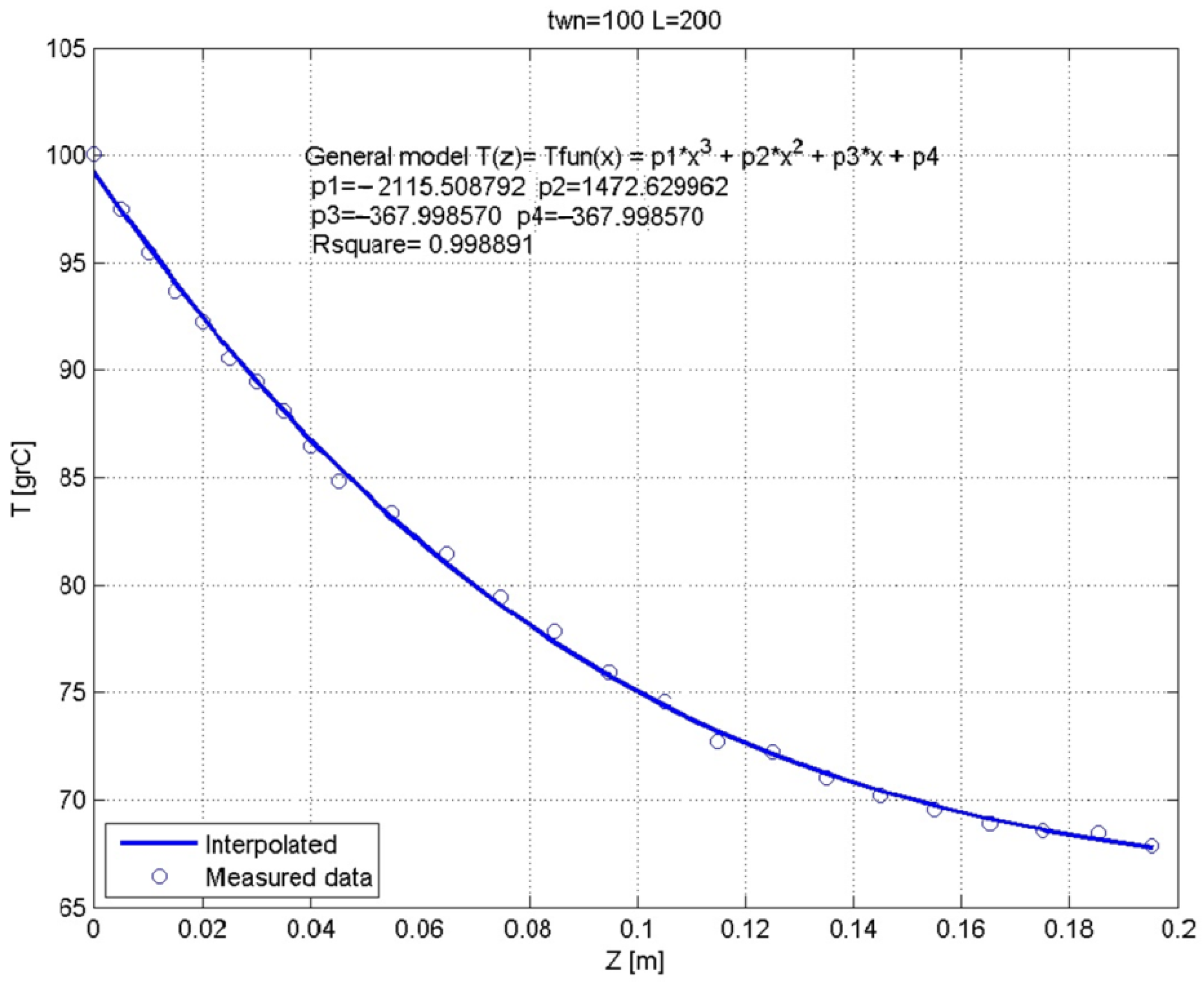

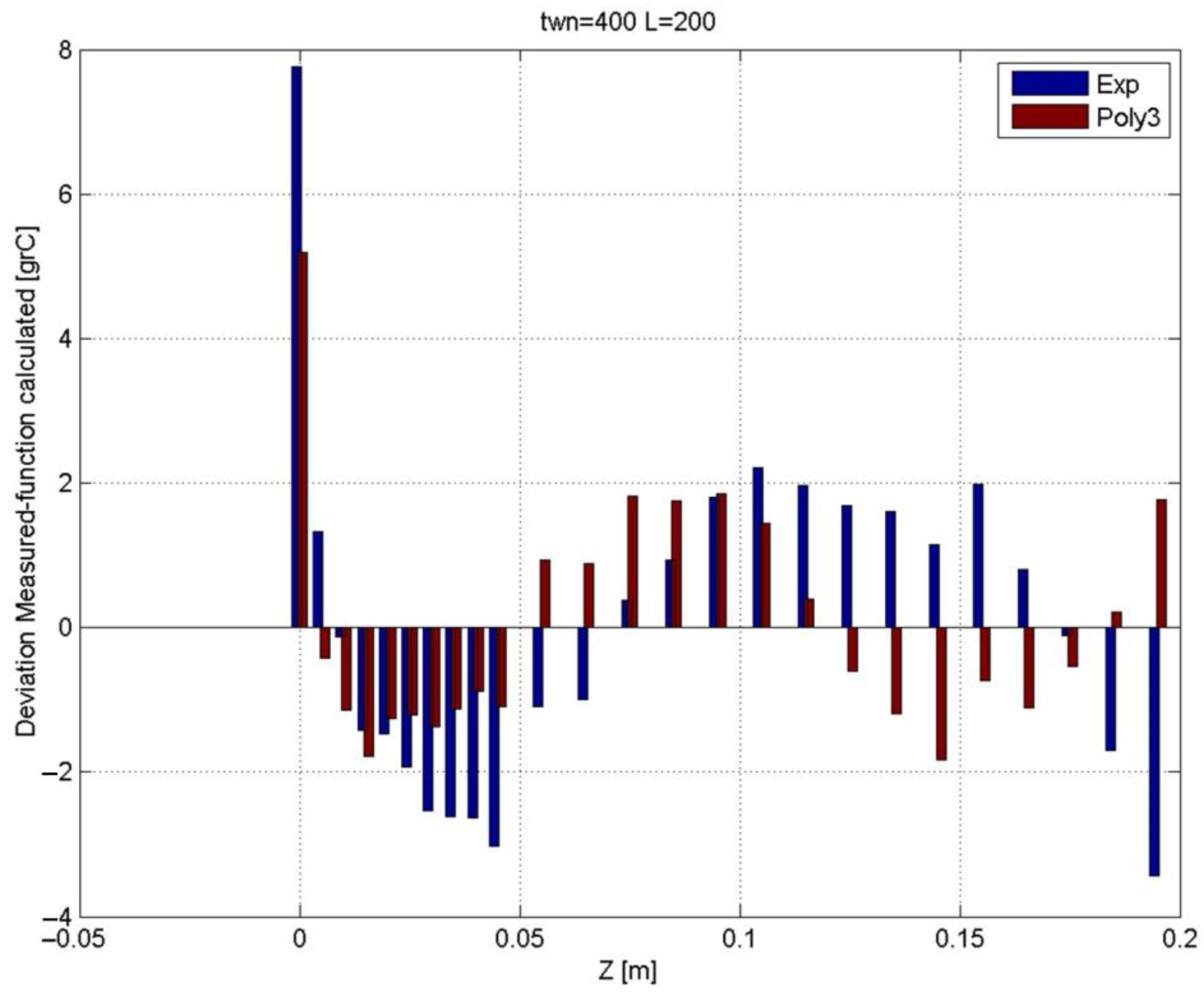

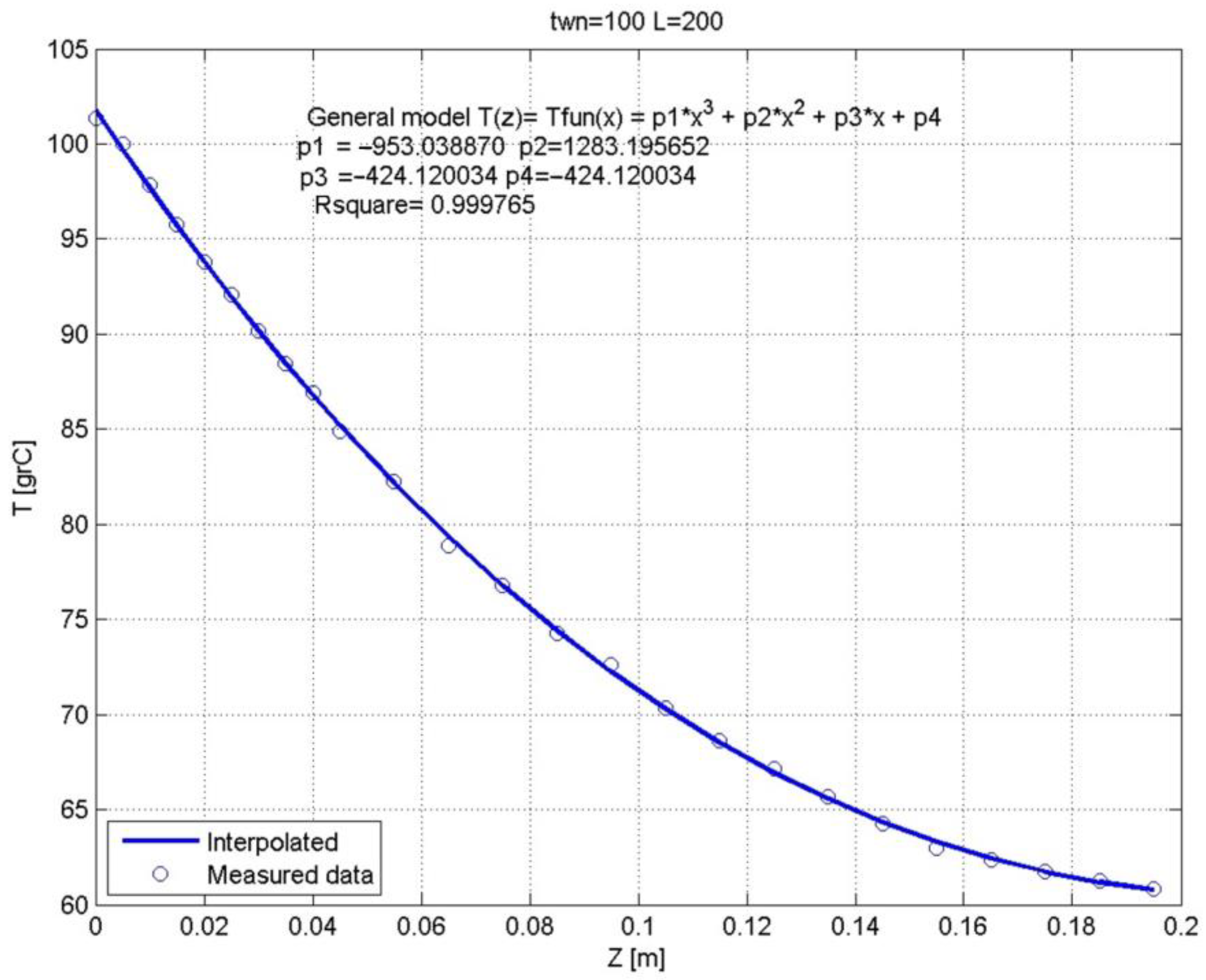
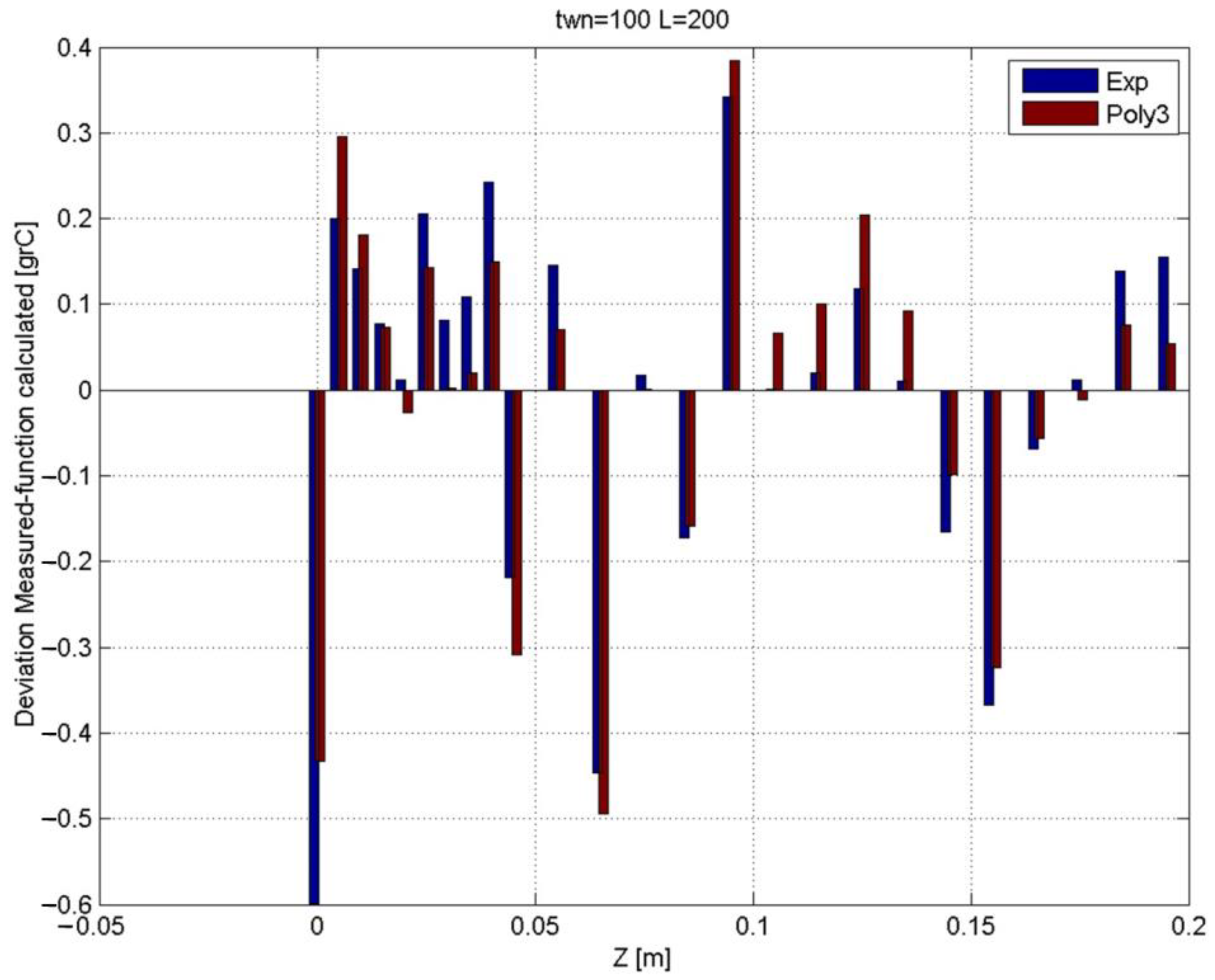

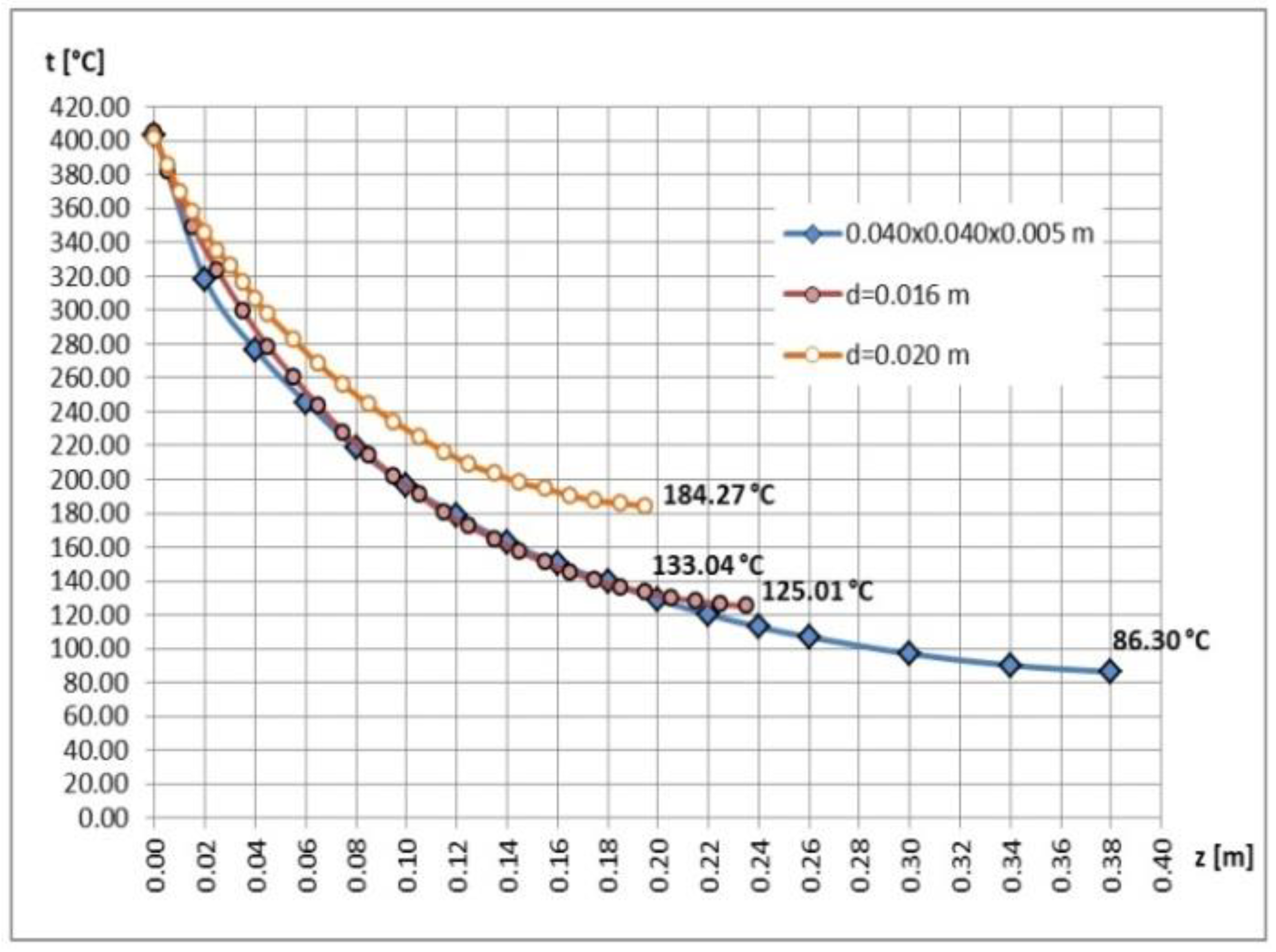
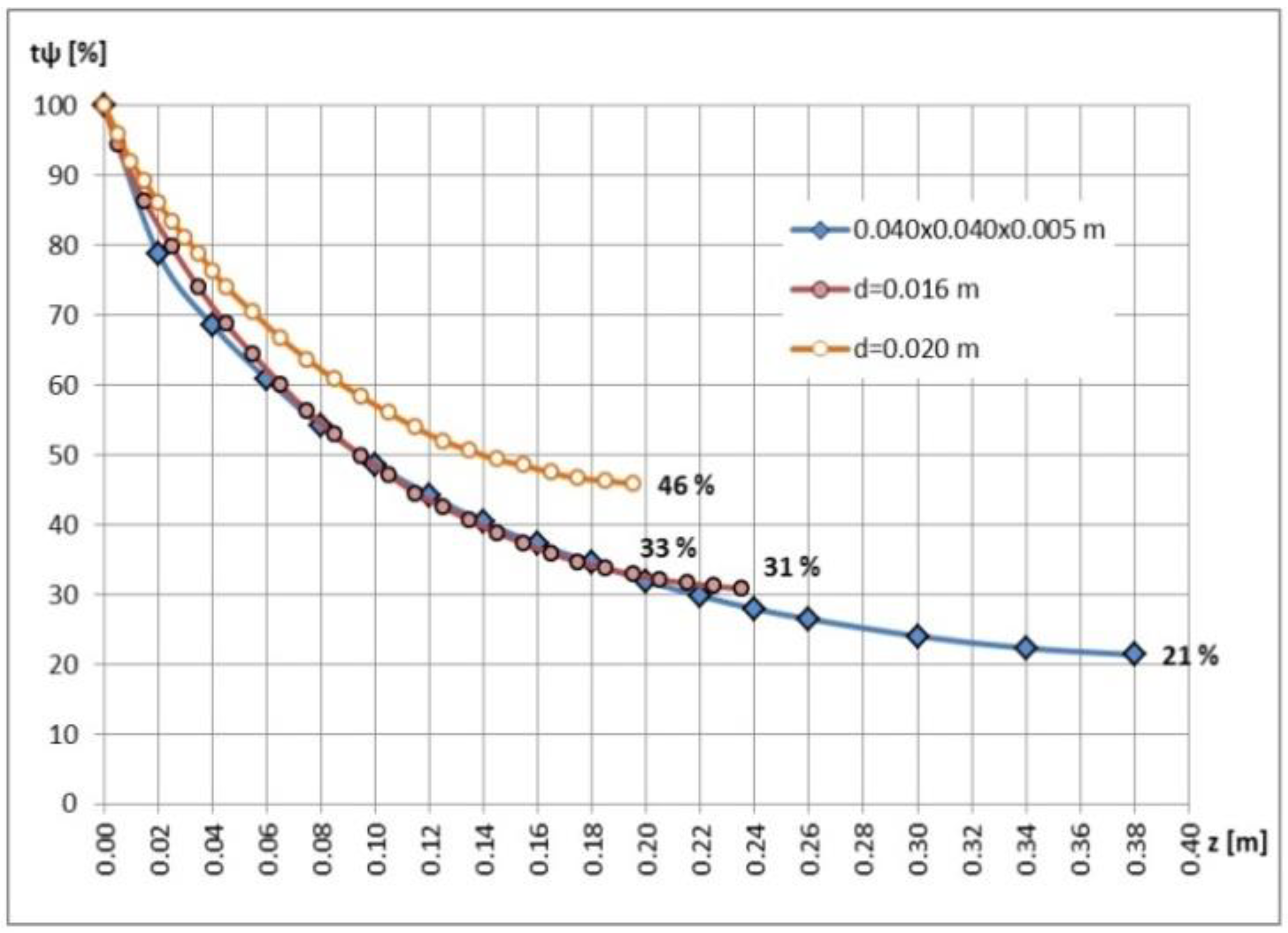

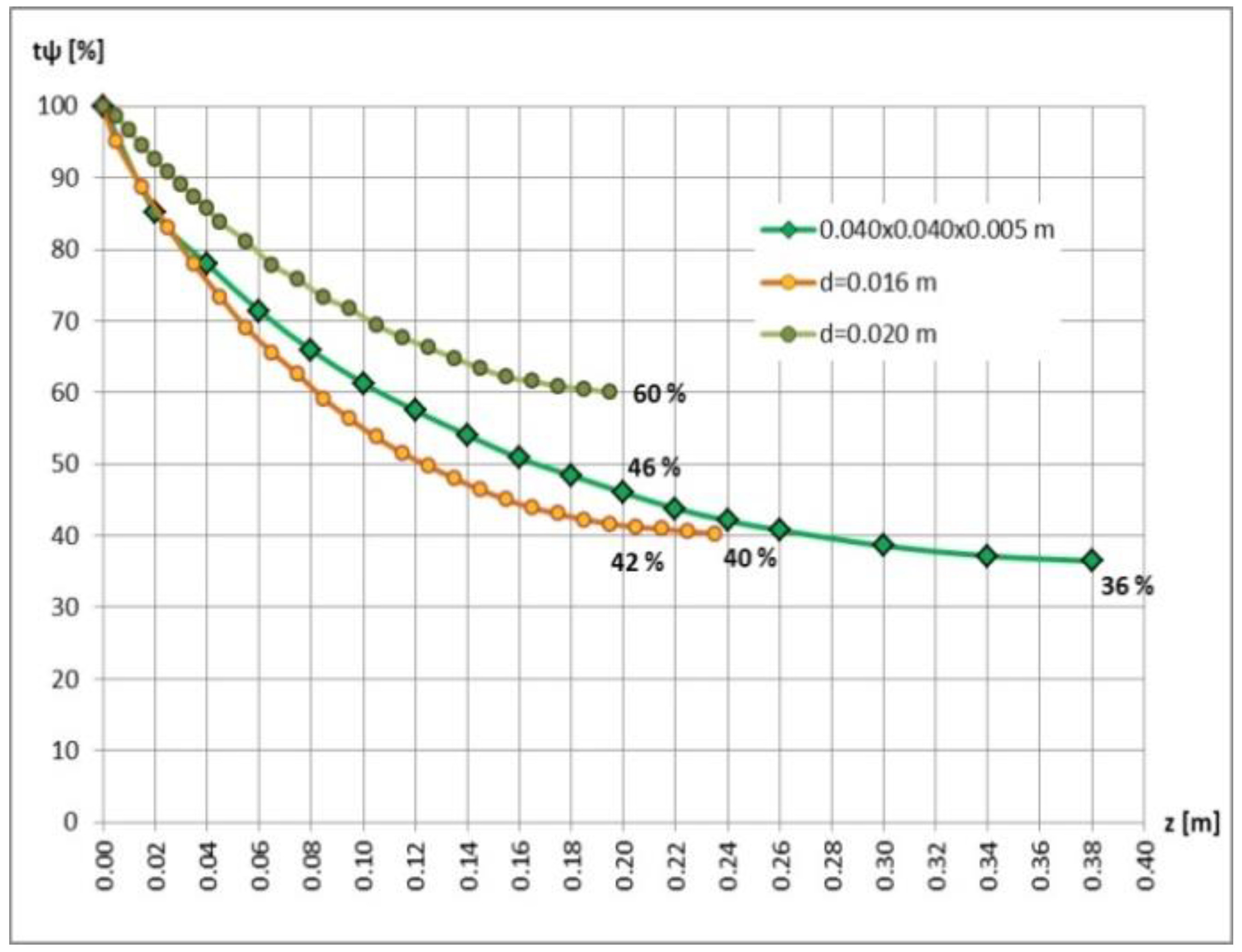
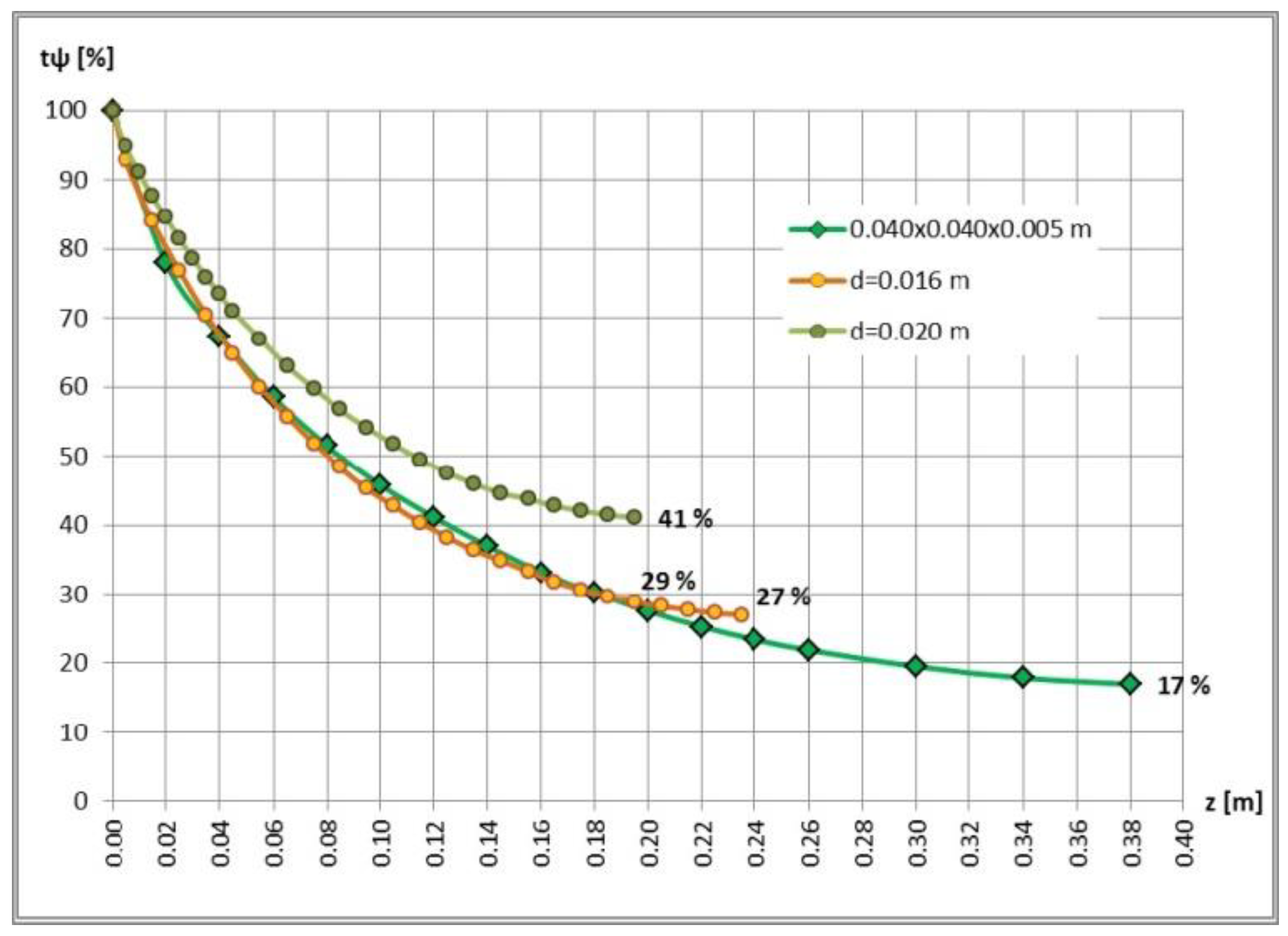

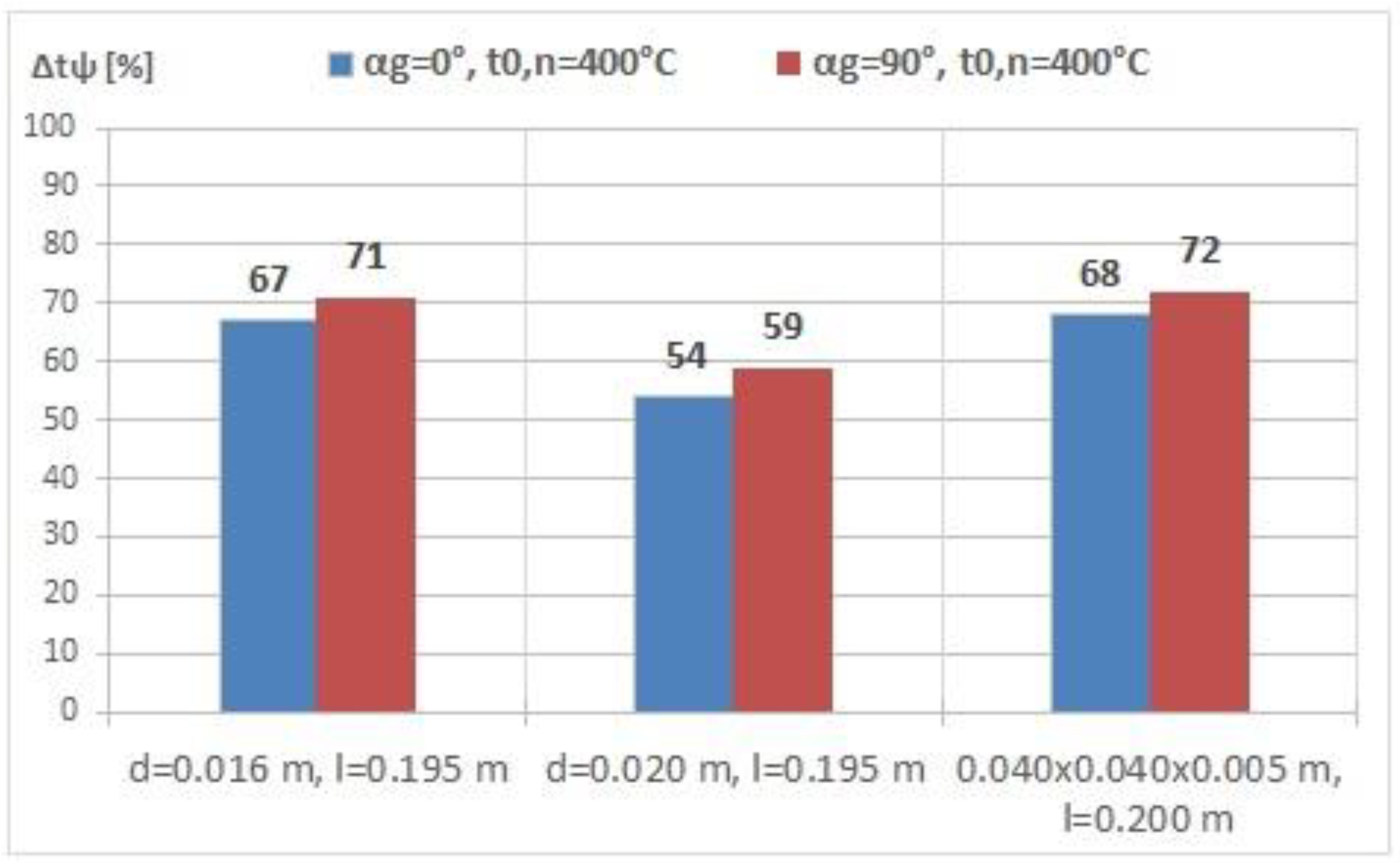
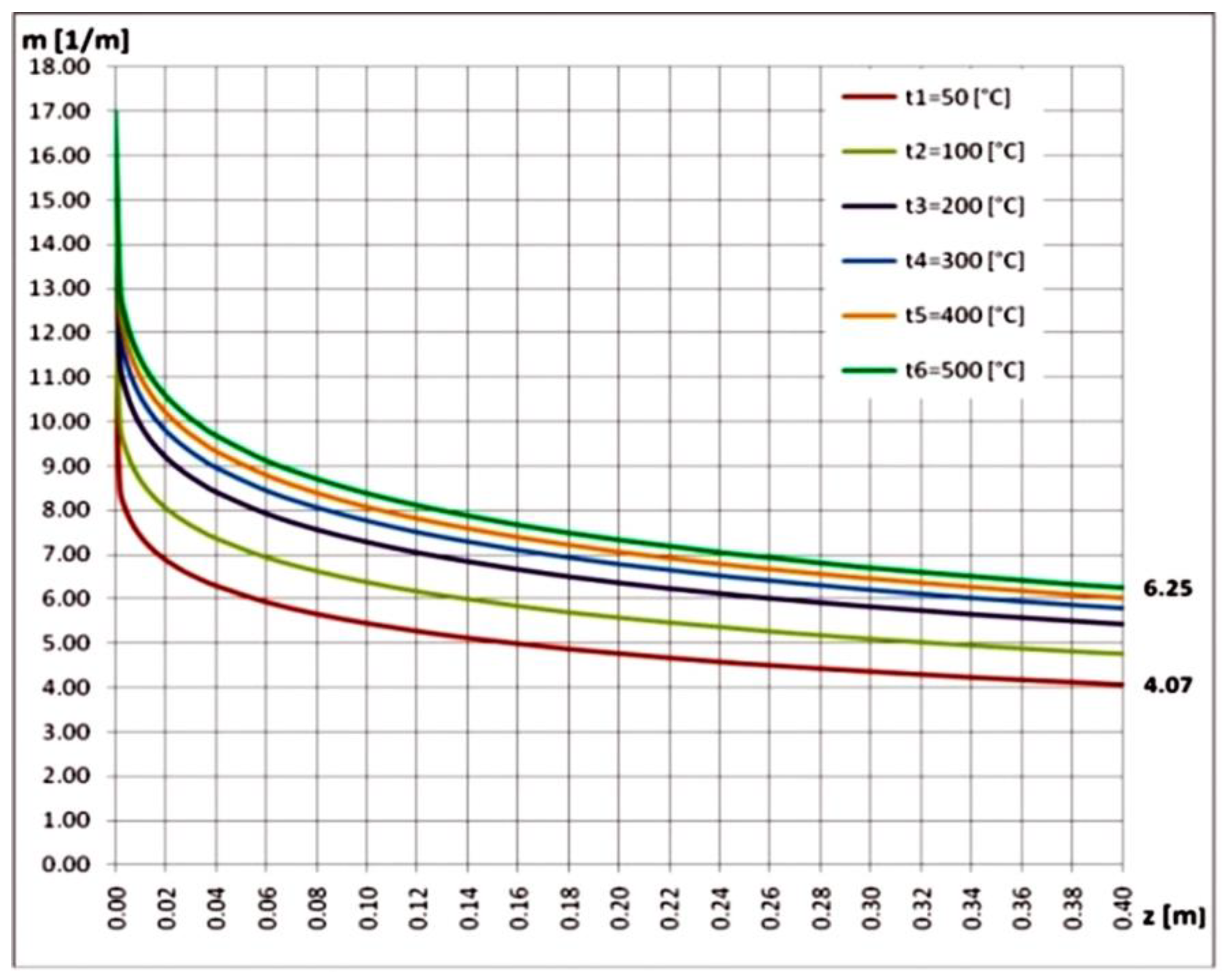
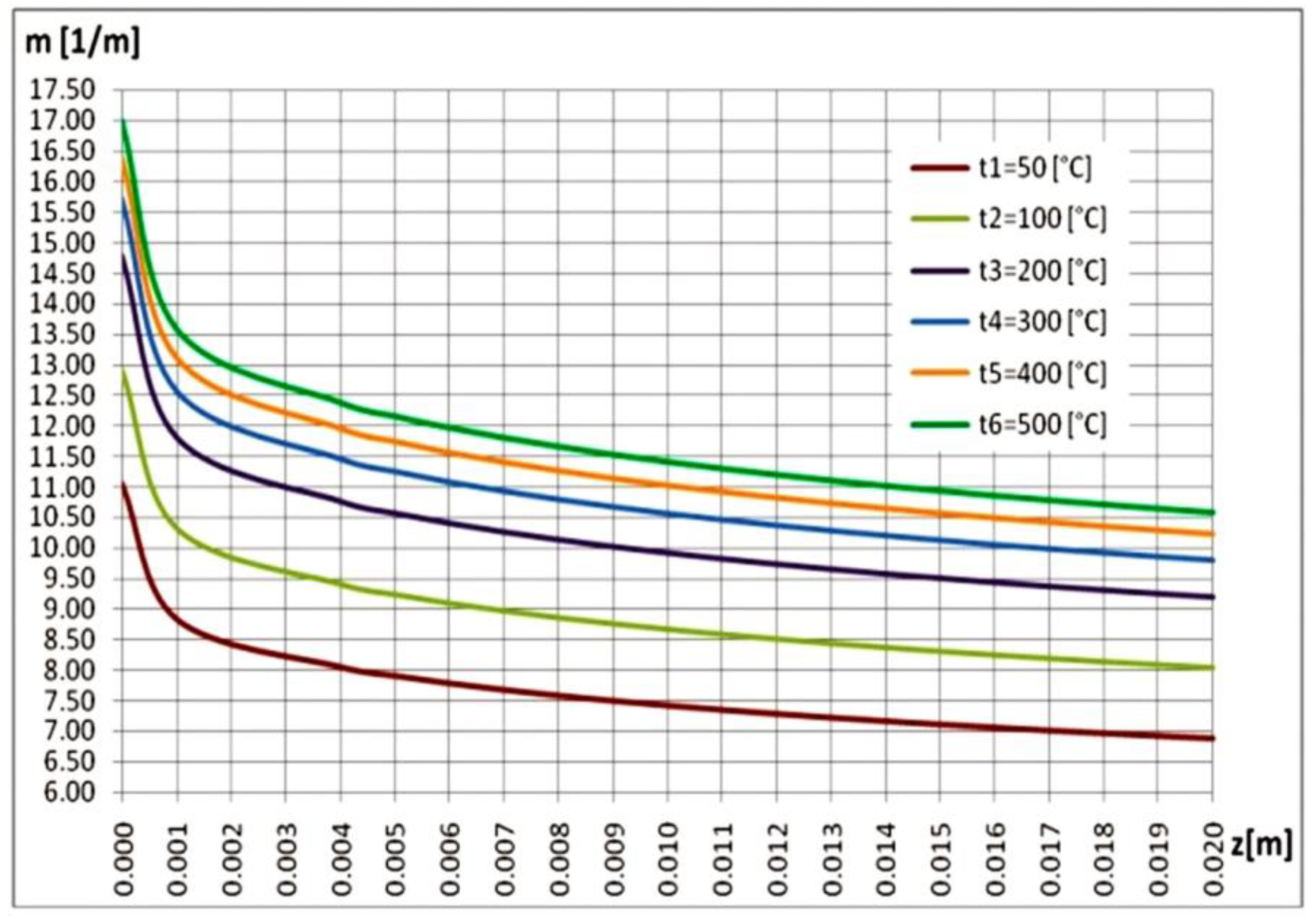
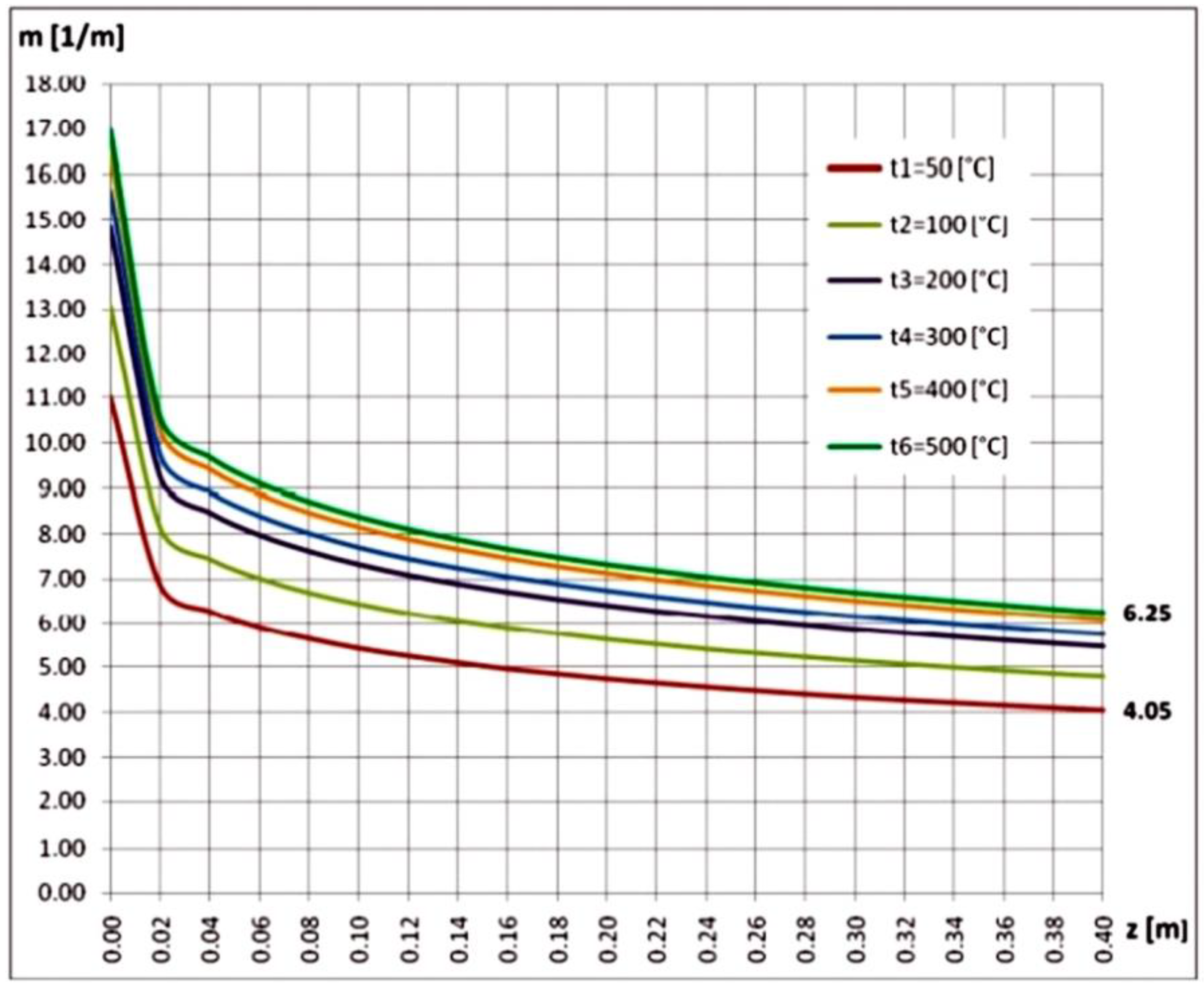



 ;
;  ,
,  .
.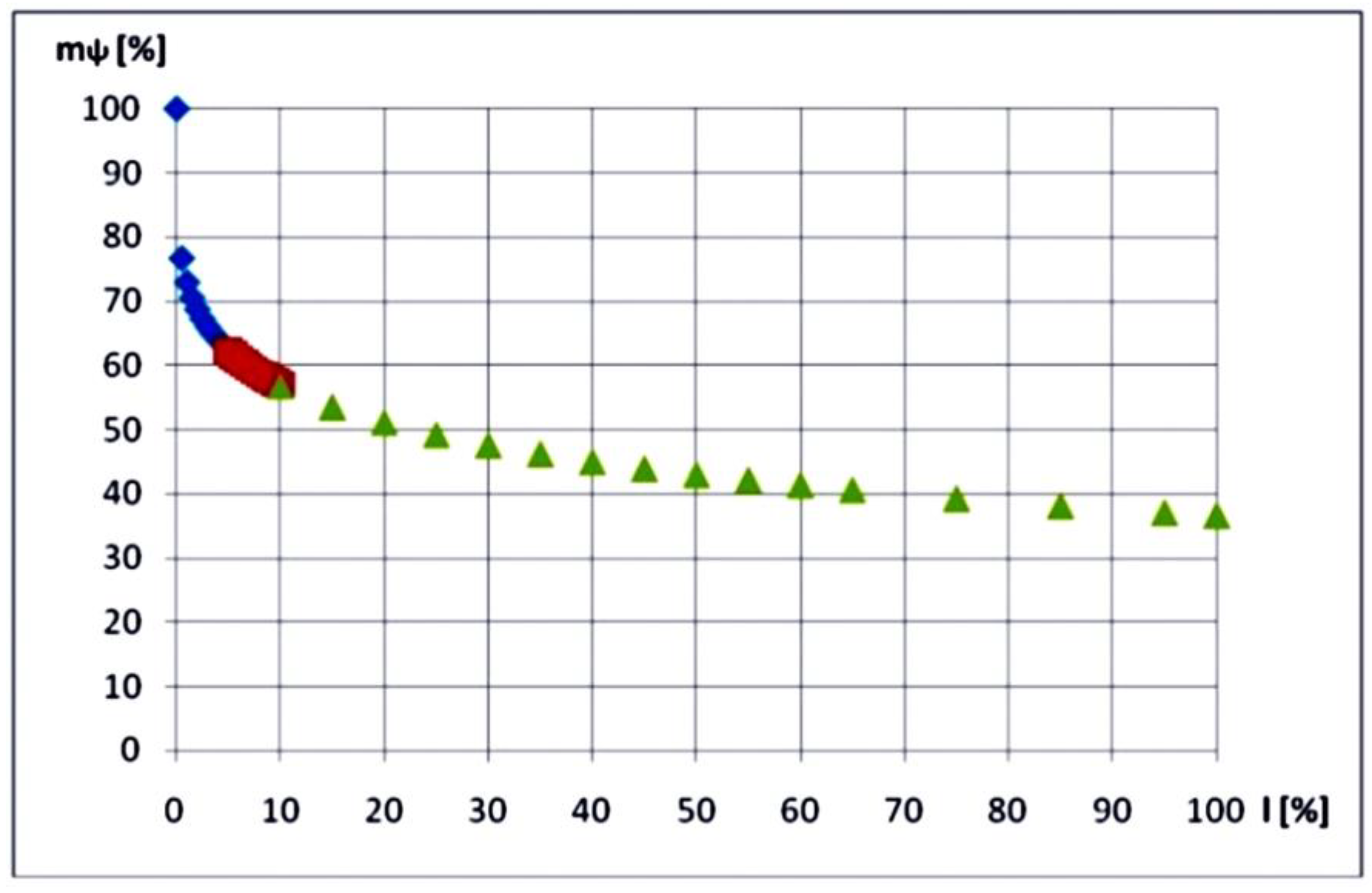

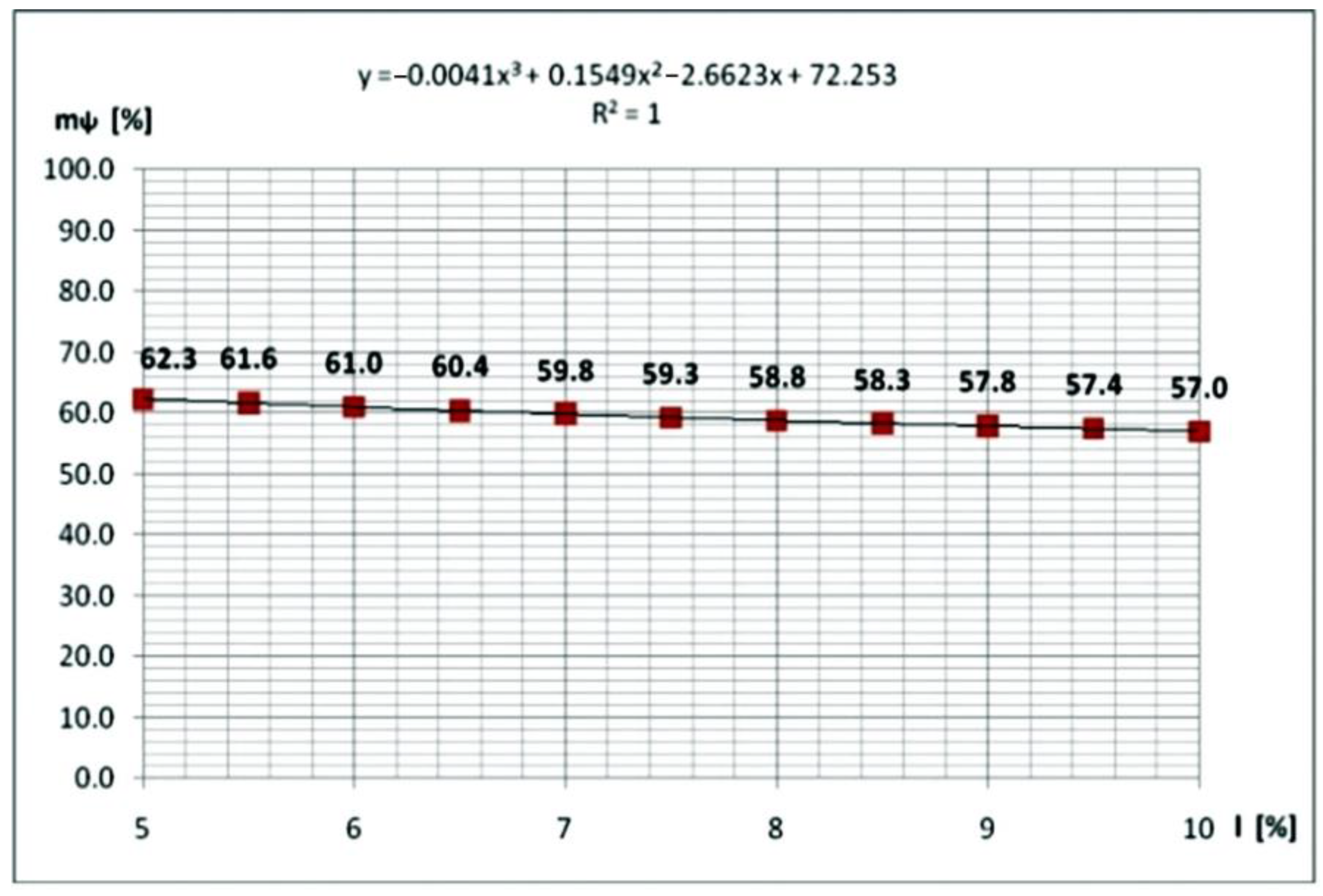
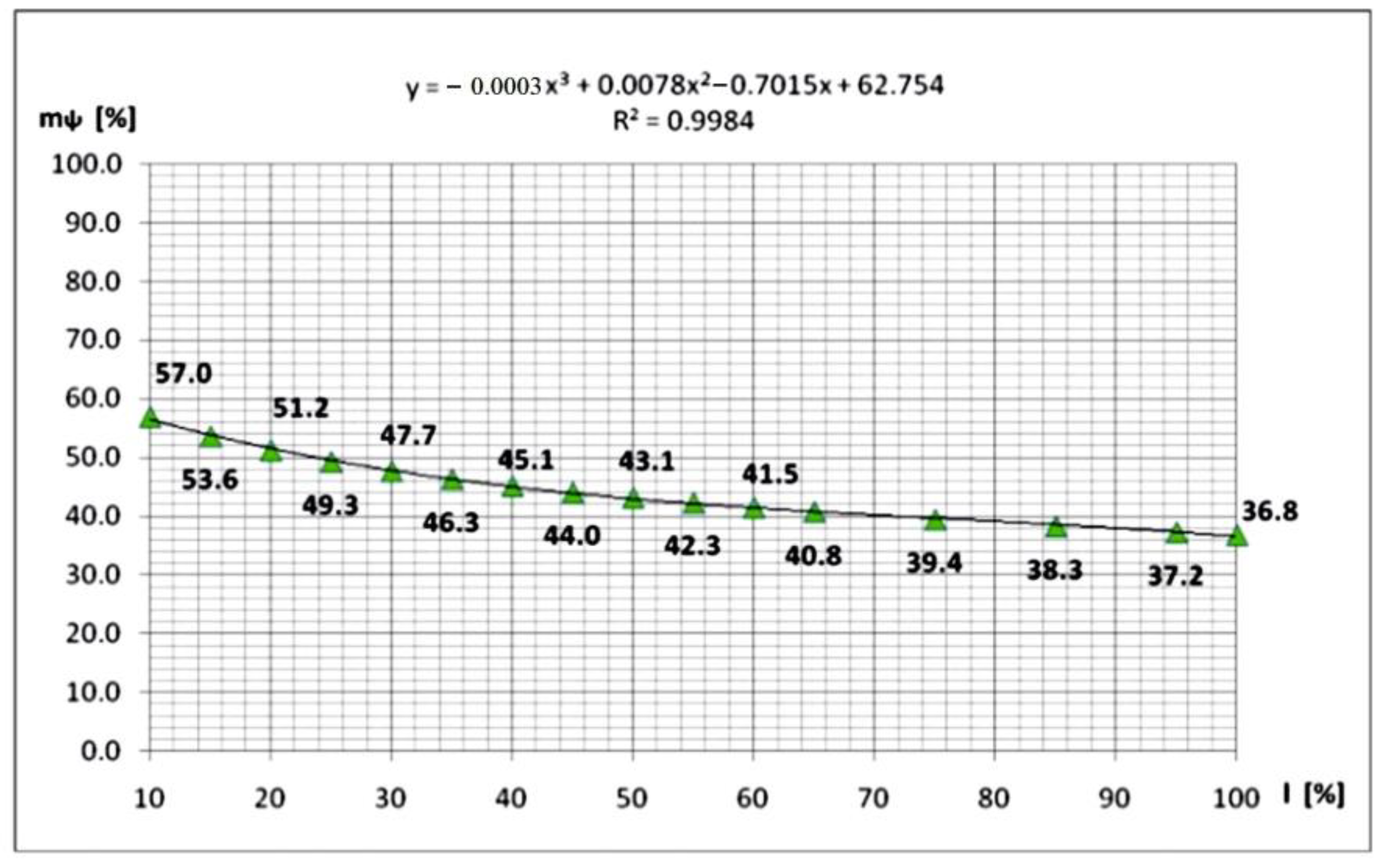
| The Analysed Point’s Number j | Massive Circular Cross-Section with Dia. d | Square-Tubular Cross-Section | |
|---|---|---|---|
| ; | ; | ; | |
| of the Analysed Points | |||
| 1 | 0.000 | 0.000 | 0.000 |
| 2 | 0.005 | 0.005 | 0.020 |
| 3 | 0.015 | 0.010 | 0.040 |
| 4 | 0.025 | 0.015 | 0.060 |
| 5 | 0.035 | 0.020 | 0.080 |
| 6 | 0.045 | 0.025 | 0.100 |
| 7 | 0.055 | 0.030 | 0.120 |
| 8 | 0.065 | 0.035 | 0.140 |
| 9 | 0.075 | 0.040 | 0.160 |
| 10 | 0.085 | 0.045 | 0.180 |
| 11 | 0.095 | 0.055 | 0.200 |
| 12 | 0.105 | 0.065 | 0.220 |
| 13 | 0.115 | 0.075 | 0.240 |
| 14 | 0.125 | 0.085 | 0.260 |
| 15 | 0.135 | 0.095 | 0.300 |
| 16 | 0.145 | 0.105 | 0.340 |
| 17 | 0.155 | 0.115 | 0.380 |
| 18 | 0.165 | 0.125 | |
| 19 | 0.175 | 0.135 | |
| 20 | 0.185 | 0.145 | |
| 21 | 0.195 | 0.155 | |
| 22 | 0.205 | 0.165 | |
| 23 | 0.215 | 0.175 | |
| 24 | 0.225 | 0.185 | |
| 25 | 0.235 | 0.195 | |
| Type of the Cross-Section | Shape Factor | Analyzed Case | The Monitored Length Ends | ||
|---|---|---|---|---|---|
| Effective Temperature | Relative Percentage | ||||
| Circular with in diameter | 250.00 | 0.195 | ; | 52.27 | 52 |
| ; | 133.04 | 33 | |||
| ; | 42.38 | 42 | |||
| ; | 116.15 | 29 | |||
| Circular with in diameter | 200.00 | 0.195 | ; | 67.87 | 68 |
| ; | 184.27 | 46 | |||
| ; | 60.85 | 61 | |||
| ; | 163.89 | 41 | |||
| Square-tubular 0.040 × 0.040 × 0.005 m | 228.57 | 0.200 | ; | 52.10 | 52 |
| ; | 128.90 | 32 | |||
| ; | 45.80 | 46 | |||
| ; | 112.60 | 28 | |||
Publisher’s Note: MDPI stays neutral with regard to jurisdictional claims in published maps and institutional affiliations. |
© 2022 by the authors. Licensee MDPI, Basel, Switzerland. This article is an open access article distributed under the terms and conditions of the Creative Commons Attribution (CC BY) license (https://creativecommons.org/licenses/by/4.0/).
Share and Cite
Turzó, G.; Száva, I.-R.; Dancsó, S.; Száva, I.; Vlase, S.; Munteanu, V.; Gălățanu, T.; Asztalos, Z. A New Approach in Heat Transfer Analysis: Reduced-Scale Straight Bars with Massive and Square-Tubular Cross-Sections. Mathematics 2022, 10, 3680. https://doi.org/10.3390/math10193680
Turzó G, Száva I-R, Dancsó S, Száva I, Vlase S, Munteanu V, Gălățanu T, Asztalos Z. A New Approach in Heat Transfer Analysis: Reduced-Scale Straight Bars with Massive and Square-Tubular Cross-Sections. Mathematics. 2022; 10(19):3680. https://doi.org/10.3390/math10193680
Chicago/Turabian StyleTurzó, Gábor, Ildikó-Renáta Száva, Sándor Dancsó, Ioan Száva, Sorin Vlase, Violeta Munteanu, Teofil Gălățanu, and Zsolt Asztalos. 2022. "A New Approach in Heat Transfer Analysis: Reduced-Scale Straight Bars with Massive and Square-Tubular Cross-Sections" Mathematics 10, no. 19: 3680. https://doi.org/10.3390/math10193680
APA StyleTurzó, G., Száva, I.-R., Dancsó, S., Száva, I., Vlase, S., Munteanu, V., Gălățanu, T., & Asztalos, Z. (2022). A New Approach in Heat Transfer Analysis: Reduced-Scale Straight Bars with Massive and Square-Tubular Cross-Sections. Mathematics, 10(19), 3680. https://doi.org/10.3390/math10193680








